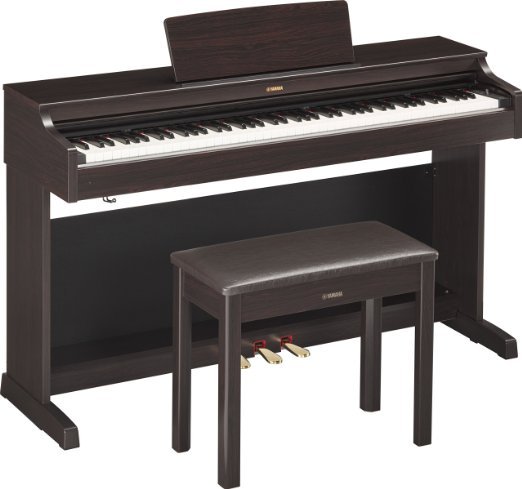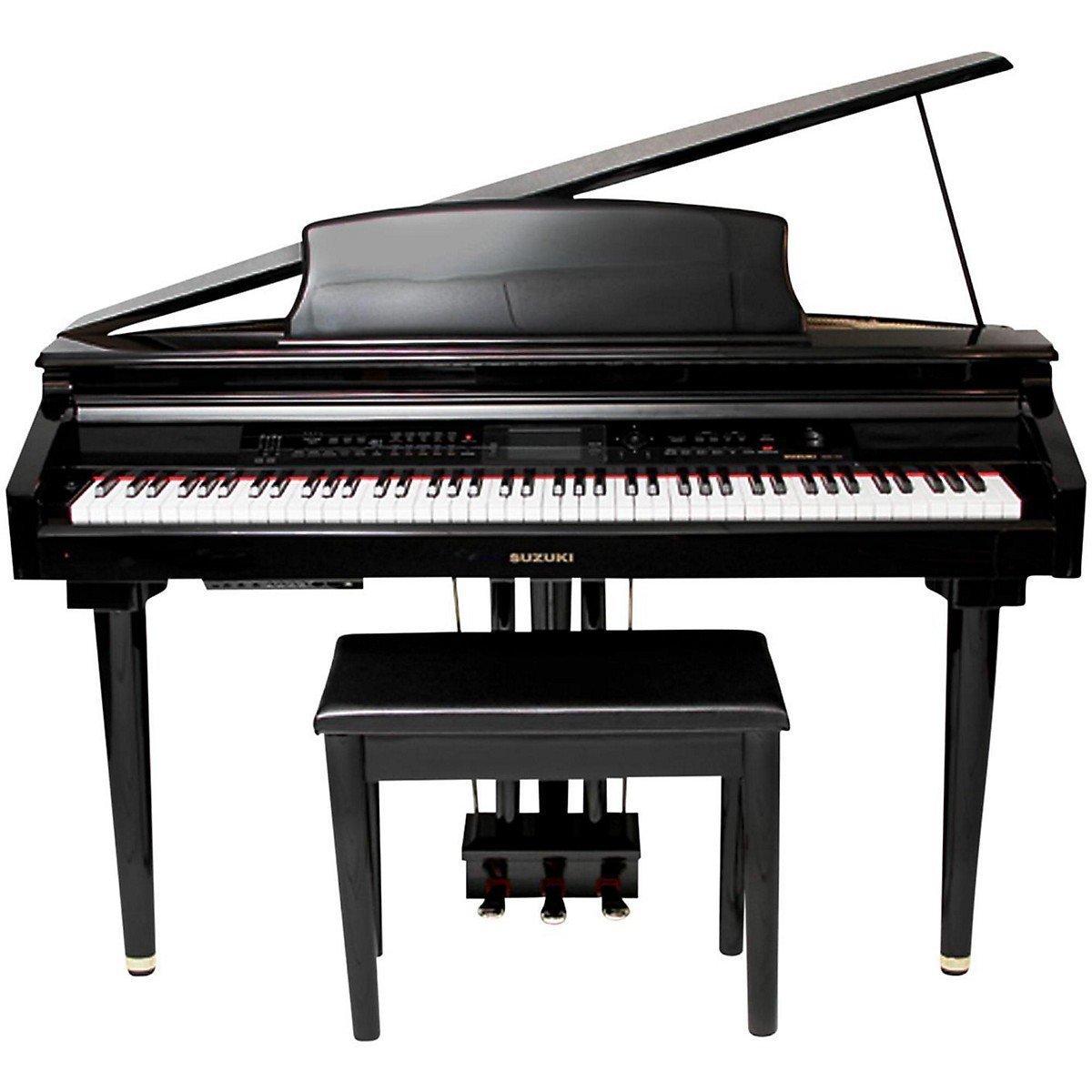Considered the gold standard in modern digital pianos, Yamaha pianos feature graded hammer effects to simulate the weighted keys on acoustic pianos. As a result, many leading music schools, such as the Conservatory of Winchester, rely on Yamaha for their electronic instruments.
With careful engineering, the construction of the pianos, from the keyboard to the pedals, is designed to simulate the touch and feel of acoustic pianos. As a result, top reviewers ranging from Consumers Digest to MMR Music Magazine have recognized the brand for excellence.
What truly separates Yamaha from some of the other brands on the market today is the focus on reproducing authentic acoustic sounds. The company’s engineers have produced a custom weighted hammer keyboard which adjusted the weight of the keys according to the 88-key scale – as a result, practicing on a Yamaha digital console translates better into actual play on a full acoustic piano.
Going beyond traditional digital playback, Yamaha pianos now feature Wave Memory which captures not only authentic individual notes but is capable of reproducing multiple levels of polyphony.
The key texture to leading classical compositions comes from the interplay of chord structures, and the Yamaha allows for accurate reproduction of these effects. Subtle differences between chord variants are clear, while the integrated stereos allow for bright reproduction of sound quality. More at https://www.brandreviewly.com/.
1.Yamaha DGX-650 Digital Piano
Learning was never more fun than with the Yamaha DGX-650 Digital Piano which provided for exclusive learning software for beginners along with a host of XG song files to learn to play songs from famous artists all over the world.
The Graded hammer Action 88-note keyboard with adjustable key-touch sensitivity that developed the correct fingering technique to play a real acoustic piano.
The Pure CF sound engine generates a lush Piano sound that is recorded from the Yamaha’s famed CFIIIS 9’ Concert Grand Piano.
The Damper Resonance effect replicates the interaction of the strings to achieve that acoustic realism in the tone.It has a maximum Polyphony of 128 notes and comes preloaded with hundreds of different voices including the Yamaha’s featured multi-instrument voices.
Yamaha has introduces a number of new and exciting features in the DGX-650 like the One Touch Setting, Smart Chord, Style Recommender for a smoother playability.
For the beginners, the DGX-650 comes loaded with the Yamaha Education Suite (YES) that comes with a built-in Chord Dictionary and a slew of lessons to learn and practice.The Piano comes with a built-in six-track recording option and a port for directly connecting a Flash Drive to store your music.
2.Yamaha YDP 181
Yamaha has made sure that their YDP 181 model from their Arius series looks and sounds amazing. The piano comes in a dark rosewood finish and will grace any room. What’s more, it also sounds as good as it looks.
The main purpose of the Yamaha YDP-181 is to have the authentic look, feel, and sound of an upright acoustic piano. The keyboard features 88 full-size keys with Yamaha’s Graded Hammer action. While this isn’t the highest grade on Yamaha models, it certainly is enough for this digital piano.
The piano features 14 voices which deliver crisp clear sounds identical to the original. The piano also has 128-note polyphony, which is enough for most piano players. For serious pianos players, the inclusion of 3 built-in pedals is a great feature.
Features of the Yamaha YDP 181
What are the features that you can expect to get with the Yamaha YDP 181?
Graded Hammer (GH) 88-key keyboard
128-note polyphony
Variable Touch Sensitivity – set to hard, medium, or soft to reflect your playing style
Advanced Wave Memory Dynamic Stereo Sampling
USB connection
Built-in recorder
2 large 20w stereo speakers
50 preset songs to play along with
Weighs 110 lbs
One of the main benefits of the Yamaha YDP 181 is the fact that it looks and feels like an authentic acoustic digital piano. It also has powerful stereo speakers which provide deep bass sounds.
3.Yamaha P115 Digital Piano
The P-series has been acclaimed for providing a line of compact, stylish and advanced Digital Pianos and the P115 is no exception with its sleek finish and a range of controls including its own iOS app.
The Piano replicates the ideal Piano tone by recording the CFIIIS 9’ Concert Grand Piano through the Pure CF Sound Engine. It can support a maximum Polyphony of 128 notes for enabling complex playing techniques.
The full-sized keyboard comes with the weighted hammer action to give the feel of a true acoustic piano and the touch sensitive fingers are equipped with Matte finish on the top for long hours of slipping-free practice.
A new effect called the SOUND BOOST has been introduced to add an extra vigor to your performance. It brightens up the notes and makes them much clearer to your audiences.
The P115 comes along with a free Digital Controller App for iOS Devices through which you can remotely control your Digital Piano by just one touch of your finger.
You can also save your favorite settings and then recall them in an instant through the Digital Controller App.
With 14 built-in voices and a variety of Rhythms and Styles, you can play any genre of music with complete accompaniment patterns generated from a single chord.
4.Yamaha YDP 143
The Yamaha YDP 143 is from their Arius range of digital pianos and this model is one of the best digital pianos on the market. It has the Yamaha Graded Hammer Standard keyboard which mimics exactly how a grand piano plays. The digital piano also features the Pure CF Sound Engine with a sample from the world-renowned CFIIIS 9′ concert grand piano. More at https://www.brandreviewly.com/the-best-yamaha-digital-piano-that-you-can-purchase-today/.
The keyboard also features a split mode, allowing you to play different voices on the keyboard or also play along with someone else.
With the inclusion of Damper Resonance technology, Yamaha makes sure that the sound you produce is just a crisp and clear as from an acoustic piano. The fact that it has 192-note polyphony is an added bonus. This means that you can play very intricate songs with ease and sustained notes won’t get clipped.
If you have an iOS device (iPad or iPhone) then you can use the Digital Piano Controller to turn it into intuitive instrument controller. With this, you can control the digital piano and also even record your own songs.
Features of the Yamaha YDP 143
What are the features that you can expect to get with the Yamaha YDP 143?
Pure CF Sound Engine sampled from the CFIIIS 9′ concert grand piano
Graded Hammer Standard (GHS) 88-key keyboard
Touch Response keyboard
Half-damper pedal
Built-in 2 track recorder
Digital Piano Controller for use with an iOS device
Stereophonic Optimizer for better a headphone sound
USB Connection
MIDI recorder
Weighs 83 lbs
The main benefit of the Yamaha YDP 143 is that you get one of the best digital pianos that Yamaha has produced in this price range. With the Acoustic Optimizer and the Stereophonic optimizer, you can enjoy authentic sounds from your digital piano through the built-in speakers or through headphones.
5.Yamaha YPG-535 Digital Piano
When you though it couldn’t get any better that’s when Yamaha surprises you with a power-packed Digital Piano that lets you explore the boundaries of good music a little further.
The YPG-535 features an 88 note graded soft-touch keyboard which offers a premium piano sound by means of the AWM Stereo Sampling for tone generation.
THE full-dot LCD display provided on board is capable of displaying the lyrics and the score of the song that you are playing on the keyboard which even scrolls automatically as you play on.
A maximum 32-note Polyphony can be accomplished on this Piano. Now you can easily play along with the Dual and Spilt mode functionality and the Damper Resonance and One Touch Setting without the annoyance of note-slipping.
Learning is now more fun with the Yamaha Education Suite (YES) and the Performance Assistant Technology that varies the tempo of the song according to your playing ability and then grades your performance so that you can work upon your performance.
6.Yamaha YPD-142 Arius Series Digital Piano
The YPD-142 Piano by Yamaha has focused intensively on giving all levels of pianists a magical experience. Believe us when we tell you it will not be easy to distinguish its tone from that of an acoustic piano.
The standard 88 note keyboard is featured again in the YPD-142 which comes with the graded hammer Standard Action. The Matte finish can be adjusted to your style of touch and 3-pedal unit further portrays the interaction of the strings via hammer action with incredible clarity.
The 128-note Polyphony is powered by the Yamaha’s signature Pure CF Sound Engine which has established its superiority in many of the previous high-end models of Yamaha.
There are 10 inbuilt voices in the Piano which can be played in the Dual and the Duo mode. Additionally the Reverb effect and Intelligent Acoustic Control can be used for defining the tone according to the settings.
A two-track recording option enables you to capture your best moments and transfer them to your computer via the USB to HOST port provided on board.
With the Acoustic Optimizer Technology developed by Yamaha, the YPD-142 can regulate the string resonance to an optimum level and turn your Digital Instrument in a full-blown Concert Grand.
A Brief History of Yamaha Digital Pianos
Yamaha originally began producing pianos in the late 19th century, and was one of the very first companies to adopt digital technology in its product lines. While the company’s electronic division has produced a wide variety of products, including computer chips, it continues to be a leader in music, producing both acoustic and digital string instruments of all types. The company’s ethos is captured in “Kando”, a motto which represents a commitment to excellence in quality.
Starting in the 1950s, digital pianos began to gain prominence in conjunction with the growth of synthesized musical production. While the earliest digital models didn’t fully emulate acoustic sounds, Yamaha continued to lead the way in innovation, introducing better sound reverberations which culminated in the development of MIDI true standards in the 1980s.
As a result of genuine digital reproduction, modern Yamaha digital pianos now transcend the tin-based resonance of earlier models, now producing tones which accurately map to actual in-tune acoustic piano notes. Today, the company’s complete line of digital pianos can be found in churches, music schools, concert halls and other playing environments as a testament to their quality.







